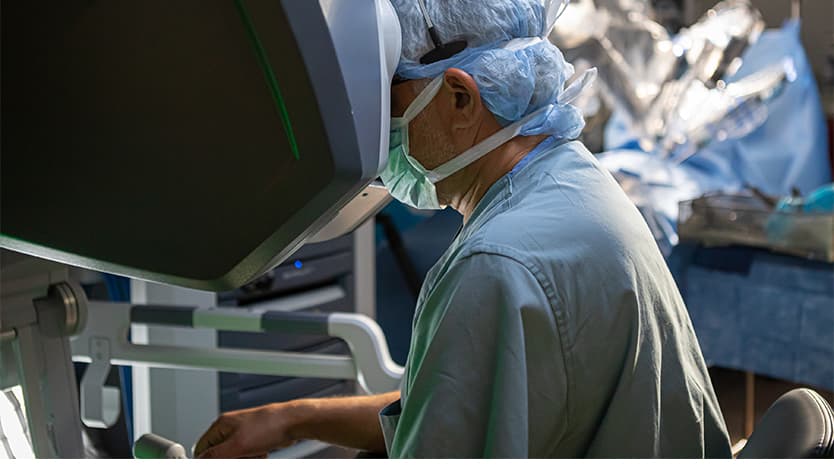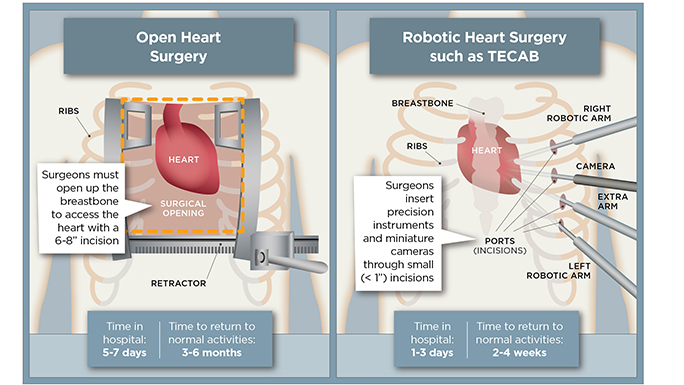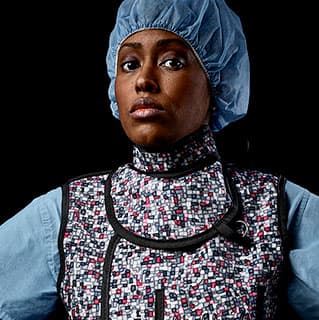Robotic heart surgery: What you need to know

As a robotic cardiac surgeon, I specialize in the treatment of coronary artery disease, heart valve disorders, atrial fibrillation and other cardiac diseases and use robotic and less invasive techniques to reduce pain, disability and recovery time. I have extensive experience in performing robotic totally endoscopic beating heart coronary bypass grafting (TECAB), robotic mitral valve surgery, robotic atrial fibrillation surgery and minimally invasive (port access) aortic valve surgery.
What is robotic heart surgery?
Robotic heart surgery is a minimally invasive approach to heart surgery, involving the use of robotic devices, miniature cameras, and precision instruments to access the heart without having to make a large incision or cut through the breastbone.
What advantages does robotic heart surgery have over traditional approaches?

Traditional heart surgery requires surgeons to open up the chest to access the heart for repair. This approach requires cutting through the breast bone and opening up the rib cage, necessitating a very large incision and causing a lot of unintended damage to the chest.
With a robotic approach, surgeons don’t have to cut through the breastbone. Instead, we slip instruments through small incisions between the ribs. This reduces the risk of post-surgical complications like infections and blood loss, dramatically reduces scarring, requires shorter hospital stays and allows for a much faster return to normal day-to-day activities. Patients also tend to experience much less pain during their recovery, because they’re not healing from a broken breastbone.
At the University of Chicago Medicine, some robotic heart surgeries are also performed without the use of a heart-lung bypass machine, thus reducing the risk of stroke and other neurological complications.
What are the risks of robotic heart surgery?
Like any surgery, a minimally invasive approach has some risks, most of which are also risks in traditional open-heart surgery. These can include complications such as bleeding, infection, stroke and arrhythmias, or an irregular heartbeat. In general, however, the risk of these complications is lower in a robot-assisted or minimally invasive surgery than in a traditional open-heart surgery. There is also a very small risk that complications during surgery will require a surgeon to change to an open-chest approach.
Who is a candidate for robotic heart surgery?
Every patient is different, and you should talk to your doctor and treatment team to figure out the best option for you.
At UChicago Medicine, we perform hundreds of these minimally invasive robotic surgeries every year, including new and innovative procedures that are not widely available. Some patients who are seen as high risk, such as those who are obese, diabetic, or who have had open heart surgery in the past, may not be considered eligible for robotic heart surgery at most institutions. But our robotic cardiac surgery team will work to customize care for every patient, and we are always striving to provide the least invasive and most effective therapies for our patients.
When isn’t robot-assisted surgery a good fit for a patient?
Whether or not someone is a good fit for robotic heart surgery is a moving target, depending on the patient’s condition and expertise of the medical team.
For example, early in my experience with the Totally Endoscopic Coronary Artery Bypass (TECAB) procedure, I would not have done this type of surgery on a patient with severe COPD or emphysema. Our approach usually meant that the patient would be maintained on only one lung during surgery, which can be difficult to achieve in patients with respiratory issues.
But now, as we’ve become more experienced, we’re able to perform the procedure without having to reduce the patient to one lung. In fact, the robot-assisted approach tends to be much better for these patients, because we don’t have to compromise the structure of their chest during the surgery which minimizes lung complications in the post-operative period.
Many different kinds of heart procedures can be performed with a minimally invasive robotic approach. These include treatment of some adult congenital conditions requiring surgical correction, correction of atrial fibrillation, valve repair and replacement, single and multiple vessel coronary artery bypass surgery, and implanting pacemakers to support the heart’s rhythm and pumping function in heart-failure patients.
Are there times when a traditional open surgical approach is better?
Not every procedure can be done with a robotic approach. Open-heart surgery may be necessary for a variety of reasons — for example, a procedure may not yet have been perfected using a robotic approach, or the operation may not lend itself to a minimally invasive approach such as heart transplantation. But in general, we like to encourage the use of the robot whenever possible. No other institution in the U.S. offers more innovative or highly advanced robotic surgery procedures than we do.
You are considered a pioneer of the beating heart TECAB procedure. What sets this approach apart from others?
Many other institutions offer a similar surgical approach called robotic Minimally Invasive Direct Coronary Artery Bypass (MIDCAB), but it's not the same as TECAB. In MIDCAB, surgeons use a robot to harvest the replacement artery from the chest, then remove the robot and cut an incision between the ribs so the surgeon can manually access the chest cavity and attach the artery to the heart by hand. While this is better than a fully open-heart surgery, it still requires an incision and spreading of the ribs to allow the surgeon's hand to get inside the chest, and is usually limited to a single bypass.
We offer the TECAB procedure, which involves no hands accessing the chest cavity, using all robotic instruments to perform coronary bypass in a totally ‘endoscopic’ fashion. This entails operating on the beating heart without use of a cardiopulmonary bypass machine We’re currently the only program in the world that performs the TECAB procedure on a regular basis and the only ones who do the procedure routinely without stopping the heart.

Husam Balkhy, MD
Husam H. Balkhy, MD, is a pioneer in the field of minimally invasive and robotic cardiac surgery. He specializes in the treatment of coronary artery disease, heart valve disorders, atrial fibrillation and other cardiac diseases, using robotic and less invasive techniques in order to reduce pain, disability, and recovery time.
Learn more about Dr. Balkhy
Robotic Heart Surgery
We're one of a handful of hospitals in the world that offers a wide range of robotic approaches for heart conditions.
Read about our robotic heart surgery expertise
Sickness is relentless. So are we.
We are a leading community of physicians, researchers and game changers. We embrace challenges and turn them into opportunities to make a difference in your life.
Learn more about UChicago Medicine's undaunted approach to care.